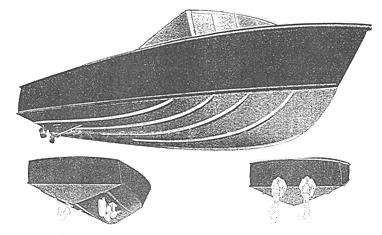I'm very suspicious of the whole schoell v20 - alim connection. In my opinion Harry Schoell is an excellent boat historian/engineer that can identify unique designs. He makes small mods to these designs and patents them. This is not unusual for patents, but what I don't like is that Schoell claims to be some great inventor, when he really hasn't invented anything . . . in my mind he simply a fraudulent self promoter.
Here's the skinny . . . as I see it.
-------------------------------------------------------------------
--------------------------------------------------------------------
FACTS:
Schoell's Dad owned Alim (the company that first built the v20)
Schoell was 18 years old when the patent for the strakes was filed in 1961.
Ray Hunt had these strakes on his 1958 "moppie" prototype in Newport, RI.
http://www.bertram31.com/ray_hunt.htm
Hunt loved to build prototypes. By 1958, a wooden deep-vee, complete with
lifting strakes and 24 degrees of deadrise, was turning heads in Newport, RI.
---------------------------------------------------------------------
Question: Where did Harry Schoell get the idea for strakes?
Drawings (for Moppie) appeared in a boating magazine early in 1958 as part of a story on the design.
----------------------------------------------------------------------
In his article:
http://www.schoellmarine.com/bio_files/page0001.htm
harry takes credit for the v20 design and boast about building a plug in a week (when he's 18 years old).
This is total "BS" there is no friggin way in hell that any one person can build a 20ft plug in a week. Teams of people can't even accomplish this.
The only way it's possible to do this in a week . . . would be to take a existing hull . . . and screw strakes to the bottom. Then spend a week shaping, fairing and polishing them, so that they could pull a mold from the plug.
-------------------------------------------------------------------------
Don't even get me started on the Delta Conic Hull or the surface piercing prop. Both these "inventions" were done way before Schoell.
Surface Piercing Prop - was a hickman design from the 20's
This shaft from the hickman seasled turned a 24inch surface piercing prop.
Delta Conic Hull - was common unpatented design.
---------------------------------------------------------------------------
Hey look at the steps on the bottom of the Hickman seasled ( that was in the 20's)
This was Richard Coles airslot hull. Check out the small step in the vee (this was in 1971)
There were many other variations of this design. I can dig up others that are much more pronounced that these 2 subtle ones.







